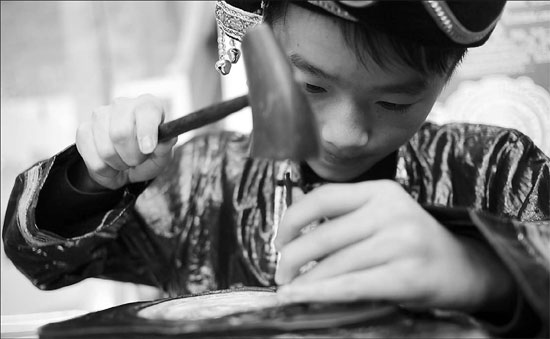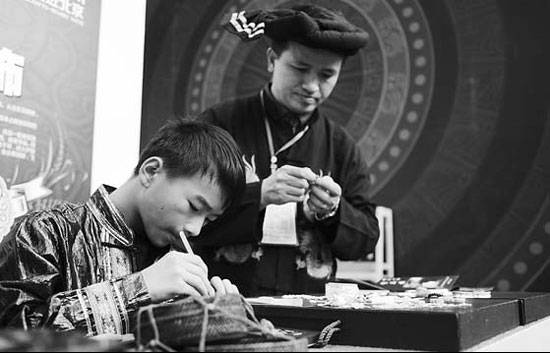Gleaming with tradition
Updated: 2012-12-27 08:01
By Zhang Yue (China Daily)
|
|||||||||
|
Li Chen, 12, concentrates on making a silver ornament at a recent Guizhou handicrafts exhibition in Beijing. Photos by Wang Jing / China Daily |
Silver crafters in Guizhou province take great pride in their cultural heritage as they struggle to preserve a dying art, Zhang Yue reports.
For 41-year-old Li Zhengyun and his family, silver craftsmanship has been a traditional skill that was kept in the Li family.
"And even in the family, it only went to males," he adds.
Members of Li's family stand out where they live in Kaili city, Guizhou province, for their skill at making exquisite silver ornaments by hand. It's a traditional skill made famous by the Miao ethnic group in Guizhou, and Miao women adorn themselves in silver ornaments and headdresses during grand festivals and celebrations.
With a silver string and a pencil, Li starts to twine a strand of silver on a pencil tip, creating the figure of a butterfly. "I do not even need to draw it on paper beforehand."
Li represents the family's ninth generation of masters at silver crafting, which is listed as one of China's intangible cultural heritages. Today, fewer local artisans are passing the skill to the next generation. In recent years, Li has been trying to teach anyone willing to learn.
"Most young people, especially males, prefer to go to cities and work as migrant workers to support their families," he says. "It brings faster and larger sums of money."
At a recent exhibition in Beijing featuring handicrafts from Guizhou, Li and his silver works attracted lots of attention.
"These decorations are special not only because they are elegant and tiny, but also because they are all purely handmade," says Wang Qi, a young customer who spent 200 yuan ($32) on a pair of silver earrings.
Also attracting attention from the crowd was Li's 12-year-old son, Li Chen, who was absorbed in making silver decorations while his father introduced their works to customers.
While the father picked up the skill at the age of 15, the son started to learn when he was 9.
He is the only boy who has excellent skills in silver processing in his class of 40-plus students. The boy has also won several awards in handicraft competitions in Guizhou.
Though the father has been to Beijing many times, this was the younger Li's first visit to the capital.
"In the past, I seldom brought him out of the home for exhibitions or business trips, because I did not want to interrupt his schooling," he says. "This time, I want to take him to Beijing for a couple of days, because I want him to visit good universities and be inspired."
The family used to live in poverty-stricken mountainous regions of Guizhou province. They moved out in the year 2000 due to its remoteness and dwindling agricultural harvests.
"Poor business is also another reason why we moved out," he says. "As we were in the mountains, few people know about our silver ornaments and there was little chance to bring our work to the broader world."
In the 1990s, when silver handicrafts were rare in Li's area, Li Zhengyun and his father used to spend years away from home, visiting villages and households to produce sets of silver works for Miao women, such as silver headpieces, bracelets and silver ox horns, which are very important ornaments during weddings, funerals and holidays.
"It was common for us to spend a year, or even several years, in one village of 500-plus households," Li says. "We were accommodated at the customers' houses while making silver crafts for them."
At that time, Li and his father earned roughly 6,000 yuan a year. That money provided food for their family, which also relied on growing corn and raising pigs.
Together with his elder brother, Li now owns a silver-ornament workshop, which receives orders and customers from all around the country, and their income has increased tenfold.
"My cousin recently opened a store selling our goods on Taobao.com," his son Li Chen says. "The business has not gone very well as it is just getting started. But we believe that things will get better."
Li Chen and his 16-year-old sister are tutored in painting once a week. Their father invites professional art teachers to teach them at home, paying 50 yuan per hour.
"Constant and early training can help to improve their skills and enlighten their art-design ideas. And this will help them go to professional art colleges like the China Academy of Art in the future," says the father.
Since 2012, the elder Li has been giving lectures in the art school of Shanghai University, China Academy of Art and Nanjing Institute of Arts and Crafts. University students majoring in arts also visit his home in Guizhou during holidays to learn the skill.

"It is our responsibility to pass the skill to younger generations as we are getting older," he says. "I wish we could expose the handicraft to more people outside of Guizhou."
He also says that today, silver decorations have changed from traditional Miao propitious figures to those that are more popular among Han people, as his workshop receives more orders from the big cities.
But in his heart, the father wishes his children would seek a life different from his.
"For most days of my life, I have worked all day till midnight on making silver handicrafts, but I make very little money," Li says. "If my children go to college, I hope they can do majors such as finance and international business. In that case, they can become businessmen and make big money, so that they do not have to work as hard as we did."
Contact the writer at zhangyue@chinadaily.com.cn.
|
Li Zhengyun and his son Li Chen demonstrate their silver craftsmanship at the Beijing exhibition. |
(China Daily 12/27/2012 page20)

 Relief reaches isolated village
Relief reaches isolated village
 Rainfall poses new threats to quake-hit region
Rainfall poses new threats to quake-hit region
 Funerals begin for Boston bombing victims
Funerals begin for Boston bombing victims
 Quake takeaway from China's Air Force
Quake takeaway from China's Air Force
 Obama celebrates young inventors at science fair
Obama celebrates young inventors at science fair
 Earth Day marked around the world
Earth Day marked around the world
 Volunteer team helping students find sense of normalcy
Volunteer team helping students find sense of normalcy
 Ethnic groups quick to join rescue efforts
Ethnic groups quick to join rescue efforts
Most Viewed
Editor's Picks

|

|

|

|

|

|
Today's Top News
Health new priority for quake zone
Xi meets US top military officer
Japan's boats driven out of Diaoyu
China mulls online shopping legislation
Bird flu death toll rises to 22
Putin appoints new ambassador to China
Japanese ships blocked from Diaoyu Islands
Inspired by Guan, more Chinese pick up golf
US Weekly

|

|









